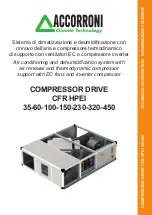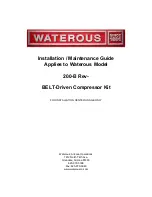
12
to the air tank of the compressor: this could
dangerously weaken the tank and will void the
warranty.
• Do not use the compressor outdoors when
it’s raining or on a wet surface; either situation
could cause an electric shock.
• Always shut off the compressor after use and
before servicing. Push the on/off knob down,
wait for the pressurised air to bleed from the
tank from the release valve and then remove
the electrical plug from the power supply.
• Check the maximum pressure rating of any
tools or accessories that you intend to use with
the compressor. The output pressure of the air
from the compressor must be regulated so that
it never exceeds the rated pressure of the tool
or accessory.
• To avoid the risk of burns and injury from
moving parts, do not operate the compres-
sor with the safety shield removed. Allow hot
parts to cool before handling or servicing.
• Do not operate the electric tool without in-
stalled guards. Please note that the compressor
will start automatically when the pressure falls
off to minimum! Disconnect from power sup-
ply prior to any servicing.
Ensure that when switching on (e.g. after ser-
vicing) no tools or loose parts are in the electril
tool.
• Be certain to read all the labels on the
containers of paint or other materials to be
sprayed.
• Always wear safety goggles or glasses when
using the air compressor.
• Do not attempt to adjust the pressure switch
or the release valve located under the pressure
switch cover.
• Drain the moisture from the tank daily. It will
help prevent corrosion.
• Pull the ring on the safety valve daily to en-
sure that it operating properly and to clear any
possible instructions.
• Keep the compressor at least 3 m from the
nearest wall to ensure adequate ventilation for
cooling purposes.
• Before transporting the compressor make
sure that the pressurised air is bled from the
tank and that the compressor is firmly secured.
• Protect the air hose and cordset from dam-
age.
Inspect for weak or worn spots regularly and
replace if necessary.
• Do not use an extension cord with this prod-
uct. Use additional air hose instead of an ex-
tension cord to prevent power loss and possi-
ble damage to the motor. Use of an extension
cord voids the warranty.
• After long working periods external metal
parts could be hot.
• Always press the on/off button down to
switch off the compressor before switching off
the power or removing the power plug.
• Do not use the compressor without first
checking the oil level. It must be close to the
red circle as viewed on the oil gauge.
NOTE: The compressor is supplied without oil.
It must be filled before the first use.
• After using the compressor, switch off the on/
off button, disconnect the power supply and
open the outlet valve to release the pressure.
• Do not attempt to remove any part of the
machine whilst is under pressure.
• Ensure that the lubricating oil is clean and
that the oil level is maintained at the correct
level. Replace the oil as indicated in the Main-
tenance section of this manual.
• Never apply the outlet air of this compressor
directly on to any part of a person’s body. Do
not attempt to block the air outlet with your
finger or any part of your body.
WARNING: In the event that an air line is
cut or broken, the air supply must be turned
off at the compressor. A broken air line which
is not supported is extremely dangerous and
can whip around very quickly, both with the
capability of striking people, and blowing for-
eign particles into the air.
FEATURES
KNOW YOUR TOOL
Before attempting to use this product, become
familiar with all of its operating features and
safety requirements.
1. 25 L TANK.
2. CRANKCASE VALVE.
3. AIR FILTER.
4. WHEELS.
5. HUMIDITY DRAIN VALVE.
COMP425A manual.indd 12
23/06/15 14:34


































